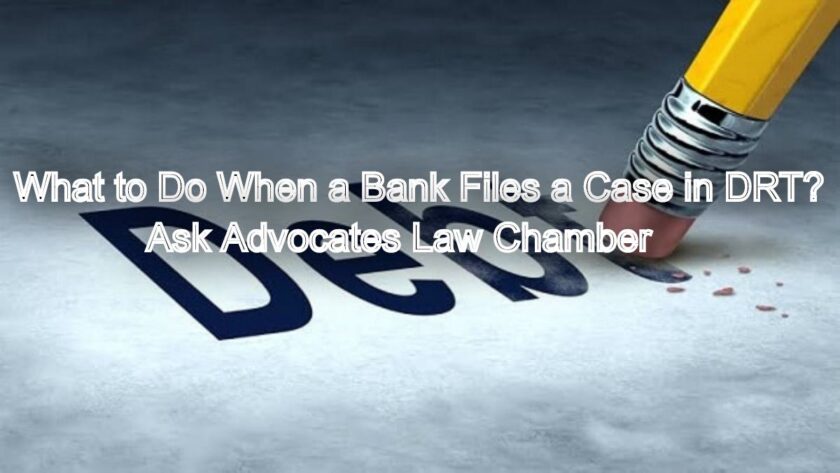What to Do When a Bank Files a Case in DRT? A bank filing a case against you at the Debt Recovery Tribunal (DRT) can feel overwhelming. Suddenly, you face a legal battle. This article clarifies your options. It empowers you with knowledge. We, at Ask Advocates Law Chamber, understand your concerns. We guide you through this complex process.
When a Bank Files a Case in DRT? Your Legal Options
Understanding the DRT and Its Purpose
First, let’s understand the DRT. The Debt Recovery Tribunal handles debt recovery cases. These cases involve banks and financial institutions. They aim to recover dues from borrowers. The Securitisation and Reconstruction of Financial Assets and Enforcement of Security Interest (SARFAESI) Act, 2002, and the Recovery of Debts and Bankruptcy (RDB) Act, 1993, govern DRTs. Consequently, the DRT has significant powers. It can order property attachment. It can also order the sale of assets. Therefore, ignoring a DRT notice is ill-advised.
Receiving a DRT Notice: Initial Steps
So, you have received a DRT notice. This document usually specifies the bank’s claim. It outlines the outstanding debt. It also mentions the legal provisions invoked. Immediately, consult with legal counsel. An experienced advocate will analyze the notice. They will explain its implications. Furthermore, they will identify any procedural irregularities. Time is of the essence here. You must respond within the stipulated period. Failing to do so can lead to an ex-parte order. This means the case proceeds without your input.
Analyzing the Bank’s Claim: Due Diligence
Next, meticulously examine the bank’s claim. Does the outstanding amount seem correct? Has the bank applied interest appropriately? Are there any discrepancies in the account statements? Consequently, gather all relevant documents. This includes loan agreements, sanction letters, and payment receipts. These documents are crucial for your defense. Additionally, verify the bank’s compliance with regulatory guidelines. Sometimes, banks make errors. These errors can weaken their case.
Legal Defenses Available to Borrowers
Fortunately, borrowers have several legal defenses. You can dispute the quantum of debt. Perhaps the bank miscalculated interest. Moreover, you can challenge the validity of the loan agreement. Was it executed properly? Was there any coercion or undue influence? Furthermore, you might argue that the bank failed to follow proper procedures. Did they issue the requisite notices under SARFAESI? Did they conduct the auction of secured assets fairly?
Challenging the Securitisation Process
Specifically, under the SARFAESI Act, banks can enforce security interests without court intervention. However, they must follow a strict procedure. They must issue a demand notice under Section 13(2). If you fail to repay, they can take possession of the secured asset under Section 13(4). You can challenge these actions. You can file an application under Section 17 of the SARFAESI Act. This application is filed before the DRT. You can argue against the bank’s actions. For instance, you can claim that the demand notice was defective. You can also assert that the asset valuation was incorrect. Therefore, understanding the nuances of SARFAESI is vital.
Negotiation and Settlement: A Viable Path
Alternatively, consider negotiation and settlement. Banks often prefer out-of-court settlements. This saves them time and resources. You can propose a one-time settlement (OTS). This involves paying a reduced lump sum. Alternatively, you can request a restructuring of the loan. This might involve extended repayment periods or reduced interest rates. A well-negotiated settlement can resolve the matter amicably. Therefore, explore this avenue seriously.
Counter-Claiming Against the Bank
In some instances, you might have grounds for a counter-claim. Did the bank engage in any misconduct? They charge excessive penalties? Did they misrepresent facts? If so, you can file a counter-claim against the bank. This can put pressure on the bank. It can also strengthen your bargaining position. Therefore, discuss this possibility with your legal team.
Appealing a DRT Order
Suppose the DRT rules against you. You still have recourse. You can appeal the order. Appeals are filed before the Debt Recovery Appellate Tribunal (DRAT). The DRAT is a higher forum. It reviews the DRT’s decision. You must file the appeal within a specific timeframe. Furthermore, you may need to deposit a pre-deposit amount. This is a percentage of the debt. Therefore, act promptly if you plan to appeal.
The Role of Your Legal Counsel
Throughout this entire process, your legal counsel plays a pivotal role. They will draft your replies and applications. They will represent you before the DRT. Will argue your case effectively. They will also advise you on the best course of action. At Ask Advocates Law Chamber, our team possesses extensive experience in DRT matters. We strategize to protect your interests. We fight for your rights. Ensure compliance with legal procedures.
Evidentiary Requirements in DRT Cases
Furthermore, remember the importance of evidence. DRT proceedings are quasi-judicial. This means they are similar to court proceedings. You must support your claims with concrete evidence. This includes financial statements, bank records, and correspondence. A strong evidentiary base strengthens your case. Consequently, maintain meticulous records.
Understanding the Recovery Certificate
If the DRT issues an order in favor of the bank, it grants a “recovery certificate.” This certificate empowers the Recovery Officer. The Recovery Officer can then proceed with the attachment and sale of your assets. This includes both secured and unsecured assets. Therefore, avoiding a recovery certificate is paramount.
Staying the Recovery Proceedings
Upon filing an appeal at the DRAT, you can seek a “stay” on the recovery proceedings. A stay order temporarily halts the bank’s actions. This provides you with breathing room. It allows time for the appeal to be heard. Consequently, requesting a stay is often a crucial step.
The Impact of Bankruptcy Proceedings
Occasionally, the debt burden becomes insurmountable. In such cases, insolvency and bankruptcy proceedings might be considered. The Insolvency and Bankruptcy Code (IBC), 2016, provides a framework for resolving insolvency. While this is a complex area, it offers a fresh start in certain circumstances. Therefore, discuss this option with your legal advisor if applicable.
Protecting Your Assets: A Proactive Approach
Finally, consider proactive measures. Regularly review your financial health. Understand your loan obligations. Seek legal advice early if you anticipate difficulties. This preventive approach can mitigate future legal challenges. Consequently, informed decision-making is key.
Frequently Asked Questions
A1: The Debt Recovery Tribunal (DRT) is a specialized quasi-judicial body in India. It handles cases where banks and financial institutions seek to recover debts from borrowers. The DRT’s establishment is under the Recovery of Debts and Bankruptcy (RDB) Act and the SARFAESI Act. Its primary objective is the swift resolution of debt recovery disputes.
A2: Upon receiving a DRT notice, your immediate action should be to consult with legal counsel. An experienced advocate will help you understand the notice’s contents and implications. They will also advise you on the necessary steps. This includes preparing a timely response and gathering all relevant financial documents. Ignoring the notice can lead to an ex-parte order.
A3: Yes, you absolutely can. Negotiation and settlement remain viable options even after a DRT case commences. Banks often prefer out-of-court settlements, such as a One-Time Settlement (OTS) or loan restructuring, to save time and resources. Your legal representative can facilitate these negotiations to reach an amicable resolution.
A4: Borrowers have several legal defenses. You can dispute the accuracy of the outstanding debt. You might challenge the validity of the loan agreement itself. Furthermore, you can argue that the bank failed to follow proper legal procedures under acts like SARFAESI. These procedural lapses can significantly weaken the bank’s case.
A5: If the DRT rules against you, it issues a “recovery certificate” to the bank. This certificate allows the Recovery Officer to attach and sell your assets. However, you still have the option to appeal this order. An appeal can be filed before the Debt Recovery Appellate Tribunal (DRAT) within a specified timeframe, often requiring a pre-deposit.
Conclusion
A DRT case can be daunting. However, it is not insurmountable. With the right legal strategy, you can defend your position. You can explore various legal options. Can negotiate for a favorable settlement. You can even challenge the bank’s actions. At Ask Advocates Law Chamber: The Best Global Force In Legal Defense, we stand ready to assist you. We provide robust legal representation. We protect your rights. Contact us immediately if a bank files a case against you. We are your dedicated legal allies. We strive for the best possible outcome.
Read More
- Director Disqualification under Section 164 of Companies Act: NCLT Remedies
- Customs Tariff Rate Conflicts with Authorities? Legal Steps You Can Take Now
- Avoid Penalties: Legal Solutions for Customs Tariff Disputes in India
- Top 10 Legal Pitfalls in Commercial Transactions and How to Avoid Them
- How to File a Company Petition Before the NCLT – Chennai Bench Explained
- Department of Financial Services, Ministry of Finance (Government of India):



